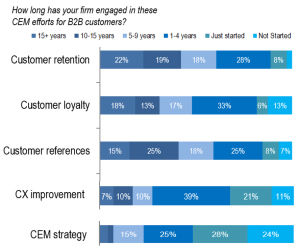
Customer engagement is the aim of any organization: it’s a sign of success and future growth. Customer engagement in co-promoting a brand is seen by many executives as THE means to customer experience business results such as increased market share, share of budget/wallet, retention, and lifetime value. But before you revel in all the hoopla, consider this question:
Customers have already exchanged fair market value for what they bought from us, so why do we believe they also owe it to us to be engaged in co-promoting our brand?
Value for value is the mantra for customer engagement best practices. It’s a two-way street, like any human relationship. Anyone can be engaged based on a too-good-to-pass-up enticement. But enduring customer engagement — with enduring business results — must be earned. Trust is the path to earning profitable engagement of customers.
Earning Customer Trust
The keys to earning customer trust are sincerity, transparency, prevention of hassles, and proactive management of expectations. As such, customer-trust-building must become a way of life at every level and in every function of your company. It cannot be managed as a program, or as the domain of your marketing department, or be viewed as a series of campaigns and promotions.
Why does customer trust “take a village”? Because distrust is caused by hassles and mis-management of expectations. And prevention of those snafus is the responsibility of all your employees, suppliers, and partners.
Hence, customer engagement is the capstone of customer experience management, not to be confused with customer experience management itself. While engagement of customers may be a means to customer lifetime value, it’s at the tail end of a series of other engagements that are the means toward it. What are those “building blocks“? It stands to reason that if you’re asking customers for inputs (Customer Voice), you have an obligation to act upon those inputs (Intelligence, Improvement, Innovation). Conversely, if you’re ignoring or glossing over customers’ inputs, what extra value are you providing to customers as the premise for them to provide you with extra value beyond the fair exchange of currency for their purchases? It goes against the recipe of sincerity, transparency, prevention of hassles, and proactive management of expectations.
Customer Experience ROI
Our research of customer experience management practices indicates inordinate emphasis on the ends with insufficient attention given to the means. More than half of firms were just getting started, or not started yet, in establishing a customer experience management strategy. Contrast that with about 15% in the same situation regarding customer references, customer loyalty, or customer retention. One-third of the companies said they are just beginning or not started yet with customer experience improvement, in addition to almost half of the firms saying they established a customer experience improvement process less than five years ago.
To reap the promised harvest of customer engagement, it must be a mirror reflection of employee engagement, driven by voice-of-the-customer, prioritized by customer intelligence and customer lifetime value, to create improvements and innovation that provide value for value. This series of building-blocks are a natural system, as a law of nature, that leads to earning the right to customer engagement and return on your entire customer experience management investment (CX ROI).

Customer experience maturity stepping stones in the customer engagement building-block are:
- Get Real: assess mutuality of “what’s in it for me” and your ratio of substance relative to sizzle.
- Get Aligned: align communications with customer experience realities and prevent premature roll-outs of any kind.
- Give Value: continue providing value to customers post-purchase.
Customer engagement is the Shangri-La of customer experience management: the capstone of a system of essential, sequential, inter-dependent building blocks. Its foundation is in customer-centered culture and holistic customer experience strategy. And its fruits are earned through systemic prevention of hassles, anticipation of expectations, and ongoing creation of mutual value. When sufficient value is offered for value requested, engagement and its attendant revenue and profit growth can be sustained.
Business Articles | Business 2 Community
(357)








